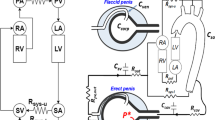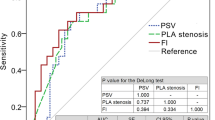Abstract
Erectile dysfunction (ED) is an increasingly prevalent medical problem, affecting up to 50% of men aged between 40 and 70-y-old. Many cases are vasculogenic and some of these stem from the inability of the penis to store blood during erection due to leak into the venous system, termed corporo-venocclusive dysfunction (CVOD). The area of leakage during erection could be the most direct measure of erectile function but has not been investigated before. We have developed a simple mathematical model to determine the area of leak during erection and have tested it on data from both normal men (n=3) and men with venogenic impotence (n=16) undergoing dynamic infusion cavernosometry (DIC). The area of leak in the impotent group is significantly greater than in normal men at intracorporal pressures above 30 mmHg and reaches a plateau between 60 and 90 mmHg. Based on this study, we suggest that it may be necessary only to perform DIC at intracorporal pressures between 60 and 90 mmHg.
This is a preview of subscription content, access via your institution
Access options
Subscribe to this journal
Receive 8 print issues and online access
$259.00 per year
only $32.38 per issue
Buy this article
- Purchase on Springer Link
- Instant access to full article PDF
Prices may be subject to local taxes which are calculated during checkout
Similar content being viewed by others
References
Feldman HA et al.. Impotence and its medical and psychosocial correlates—results of the Massachusetts male aging study J Urol 1994 151, 54–61
Krane RJ, Goldstein I, Saenz de Tejada I . Impotence. New Engl J Med 1989 321, 1648–1659
Nehra A et al.. Mechanisms of venous leakage: a prospective clinico-pathological correlation of corporeal function and structure. J Urol 1996 156, 1320–1329
Goldstein I . Vascular diseases of the penis. In: Pollack WB (ed). Clinical Urography Saunders: Philadelphia 1990 2236–2246
Murdock JW . Fundamental Fluid Mechanics for the Practicing Engineer. Marcell Dekker, Inc: New York 1993
Venegas JG, Sullivan MP, Yalla SV, Vickers MA . Assessment and modeling of the physical components of human corporovenous function. Am J Physiol, Heart Circulation Physiol 1995 269, H2109–H2123
Author information
Authors and Affiliations
Corresponding author
Rights and permissions
About this article
Cite this article
Mulhall, J., Damaser, M. Development of a mathematical model for the prediction of the area of venous leak. Int J Impot Res 13, 236–239 (2001). https://doi.org/10.1038/sj.ijir.3900699
Received:
Accepted:
Published:
Issue Date:
DOI: https://doi.org/10.1038/sj.ijir.3900699
Keywords
This article is cited by
-
Cavernosometry: a theoretical analysis
International Journal of Impotence Research (2004)



